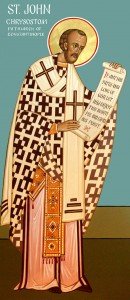 In this article I have been considering St. John Chrysostom’s ideas about the Transfiguration of Jesus. I would like to now share some further thoughts just about the Transfiguration which may, or may not, be connected to St. John since I feel that this feast is of particular importance to Eastern Christian spirituality.
In this article I have been considering St. John Chrysostom’s ideas about the Transfiguration of Jesus. I would like to now share some further thoughts just about the Transfiguration which may, or may not, be connected to St. John since I feel that this feast is of particular importance to Eastern Christian spirituality.
Relatively speaking, the transfiguration is a theme that is relatively neglected in Western Christianity. In our Church and Eastern Christianity, however, it has been kept more lively, at a theological and liturgical level. Historically, in 1456 Pope Callistus III ordered its celebration on August 6th as thanksgiving for victory over the Turks – an irony, if we connect the transfiguration with the call to suffering or self-denying discipleship in the passages which precede the accounts of it in the Synoptic Gospels. But this feast actually goes further back that this in Western Church history, predating the separation of Western and Eastern communions in the eleventh century. Still, the subject will strike some as better adapted for consideration by the more mystical mentality of the Eastern Church than the more rational Western one.
It probably comes as a surprise to many to discover that the accounts of the transfiguration of Jesus are central to the Synoptic Gospels. At the half-way junction in both Matthew and Mark, we come to Peter’s confession of Christ at Caesarea Philippi, from which point Jesus begins to explain to his disciples that He must suffer and die. The story from there on moves to its climax in the death and resurrection of Jesus. But as the narrative resumes its course, after the teaching which follows the prediction of the passion, we have the story of the transfiguration. In Luke’s Gospel, the account is earlier than in the other two, in relation to the quantity of his material, but it follows structurally in the same sequence: Peter’s confession; prediction of death and resurrection; teaching; and transfiguration. It is also located at the same significant juncture as it is in Matthew and Mark in relation to the overall account of the Gospel for, at Luke 9:51 (why not look it up), shortly after the transfiguration, we read that the time approaches for Jesus ‘to be taken up into heaven’ and so he ‘resolutely sets out for Jerusalem’. The end is already in sight.
The Eastern Church, looking at how the Gospels have presented this event in the life of Jesus, have looked to the ‘message’ of the transfiguration as important for our spirituality.
